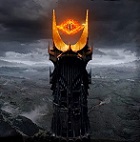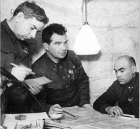loki100
Posts: 10920
Joined: 10/20/2012
From: Utlima Thule
Status: offline

|
quote:
ORIGINAL: Leber
I think the problem here is that the unrealistic Soviet blizzard offensive is a response to an incredibly unrealistic Axis advance in 1941. In the game it's suicide for a Soviet player to fight forward against a reasonably skilled Axis player; it just leads to more encirclements for next to no gain. Launching attacks leads to nothing but massive losses. The Axis can keep attacking right up until the last snow turn with little change in combat power.
This is very different from historically where after the initial frontier battles the combat situation changed dramatically. At the Battle of Smolensk the Axis spent weeks trying to close up it's encirclement of Soviet armies west of Smolensk, with the entire battle degenerating into a bloody slog. Soviet losses were still incredibley heavy, but the net effect was that Axis forces were also worn down. In WITE this would never happen against a skilled Axis player.
Throughout 1941 the Soviets launched numerous counterattacks, even Front-wide counteroffensives; they universally failed, and badly, but they wore down and delayed Axis forces, sometimes for weeks! In WITE attempting this against a skilled Axis played would be a horrible strategy.
Historically by November of 1941 Axis forces were worn down to the point where they simply could not advance. At Rostov and Tikhvin in November of 1941 the Soviets launched successful counteroffensives even before the "official" start of the blizzard period. Around Moscow German offensives ran out of steam and ground to a halt, unable to advance further against Soviet resistance. A culmination of months of fighting crippled Axis forces.
The Soviets were also worn down, but they had fresh reserve armies to commit to battle. Thus the winter counteroffensive began; not with massive weather penalties, but the commitment of fresh Soviet reserves against exhausted Axis forces. The result, naturally, was an Axis defeat.
However, as Pelton has said, Soviet capabilities were still limited and they were unable to encircle large Axis formations, and often themselves were overextended and encircled. The "broad front" advance seen in most Blizzard offensives was simply beyond Soviet capabilities.
This cuts to the essence of what is nearly impossible to simulate. In reality when the Soviets went over to the offensive they had a small advantage in numbers across the front and this concentrated at Moscow. So not surprisingly all they achieved on most sectors was to drive back over-extended advanced units. The only front to make real progress, in addition to those around Moscow, was Koniev's Kalinin. In part because he was exceptionally able and in part as he could make use of the disruption to the German defense caused by the Moscow offensive.
Now the Soviets had got themselves in that position for a mixture of reasons. Major encirclements such as Kiev that were completely avoidable and that, in any simulation, just will not happen (unless hard wired in some way) and heavy losses in localised, and near continual, counterstrokes. These did a lot of damage to the Germans too but in this game are just an easy way to inflict one sided losses on the Soviets. So in-game, say from July-October, the Germans will not gain the secondary massive pockets they historically did, nor will a Soviet player indulge in the constant, ill prepared, localised offensives. So inevitably come the chance to counterattack the Red Army is going to be stronger.
The second bit you can never simulate is mindset. Hitler believed he had a chance to take Moscow in late 41 so gambled, and lost. Equally most German players come 1943 will go over to an active defense and never risk a Kursk if the balance of forces is reasonably historical. But then as a player, you know you can 'win' if you hold Berlin in Autumn 1945. To the German leadership, the Red Army arriving in Berlin at any stage meant they had lost. So on that basis a wild gamble that just might succeed was better than accepting the inevitable?
What is wrong in the blizzard period is two-fold. First, the real relative balance of forces will never occur. So inevitably, the Soviet blow will be that much stronger. Second the mechanism hands too much advantage to the Soviets and overstates their capabilities. Again, in reality, the Winter offensive, as a coherent plan, was over by the end of January, all that was left was a series of localised battles ending in the disaster at Kharkov.
There is another problem that we are players and are looking to win. One reason why the offense often seems so strong is we will never let an advantage slip away, so once we start to dominate we will do all we can to maximise the potential advantage. There's not much that can be done about that except to play with imposed restraint - something that is easy in SP and near impossible in PBEM.
For what its worth, if there is one mechanism I'd like to see changed its the effect of isolation. This happens too fast and is too devasting, making it so much easier to finish off bypassed units. As it was both sides had real problems dealing with stubborn by-passed formations, the Soviets were still defending Brest-Litovsk into July.
|
 Printable Version
Printable Version










 but nonetheless in my other game with other opponent I had to be over cautious not to attack even need to,wonder how that will turn out in blizzard.
but nonetheless in my other game with other opponent I had to be over cautious not to attack even need to,wonder how that will turn out in blizzard.
 New Messages
New Messages No New Messages
No New Messages Hot Topic w/ New Messages
Hot Topic w/ New Messages Hot Topic w/o New Messages
Hot Topic w/o New Messages Locked w/ New Messages
Locked w/ New Messages Locked w/o New Messages
Locked w/o New Messages Post New Thread
Post New Thread